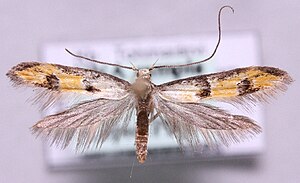Heinemannia laspeyrella
| Heinemannia laspeyrella | ||||||||||||
|---|---|---|---|---|---|---|---|---|---|---|---|---|

Heinemannia laspeyrella |
||||||||||||
| Systematics | ||||||||||||
|
||||||||||||
| Scientific name | ||||||||||||
| Heinemannia laspeyrella | ||||||||||||
| ( Huebner , 1796) |
Heinemannia laspeyrella is a butterfly ( moth ) fromthe grass leaf miner family (Elachistidae).
features
The moths reach a wingspan of 17 to 21 millimeters. The head is light yellow, the thorax yellow. The tegulae are dark gray-brown and bordered yellow inside. The forewings are deep yellow and have a dark brown costal line that becomes paler towards the wing tip. A dark brown oval spot is located in front of the middle of the wing, it extends from the costal line to almost the costal fold. A tuft of dark brown protruding scales is located above and below the costal fold. A dark brown spot with a tuft of scales in the middle is formed at the inner corner . The base of the costal line, the two dark brown spots and the tufts of scales have a very tight white border. The fringed scales are gray-brown. The hind wings shimmer dark gray-brown.
The uncus is absent in the males ; the gnathos arms are very short and end in large bubbles covered with rows of spines. The tegumen is long and narrowed distally . The blades are long, wide at the base and narrow in the middle. The tip is rounded. The anellus lobes are large and about half the length of the valves. They taper distally and have some blunt spines at the tip. The aedeagus is long, narrow, tubular and slightly curved. H. laspeyrella can be distinguished from Heinemannia festivella and Heinemannia albidorsella on the basis of the Gnathos arms. These are almost the same width as the distal part of the valves. The aedeagus is studded with rows of spines in the vesica.
In females the anal papillae are long and narrow. The Apophyses posteriores are about a quarter longer than the Apophyses anteriores. The ostium is broad and cup-shaped. The antrum is provided with a pair of short sclerotized bars. The ductus bursae is long and narrow and slightly widened towards the corpus bursae. The widest part is more or less granulated. The eighth tergite is rectangular and about one and a half times as long as it is wide. The confluence of the ductus bursae and corpus bursae is very finely granulated. The corpus bursae is egg-shaped and has no sign.
Similar species
The head and thorax of H. laspeyrella are yellow. In connection with the deep yellow forewings, the species can be differentiated from Heinemannia festivella and Heinemannia albidorsella .
distribution
Heinemannia laspeyrella is native to Northern , Central and Eastern Europe . In the east, the distribution area extends to the Urals and southern Siberia .
biology
The caterpillars were detected on the pea-like flat pea ( Lathyrus pisiformis ), the spring flat pea ( Orobus vernus ) and species of clover ( Trifolium ). Butterflies were caught on blackening pea ( Lathyrus niger ). The caterpillars develop from July to the first half of August and feed in the seed pods. Up to six caterpillars can live in one pod. The adult caterpillars overwinter in the bark of neighboring trees. The species forms only one generation per year, the moths fly from mid-May to early July.
Systematics
The following synonym is known from the literature:
- Tinea laspeyrella Huebner , 1796
swell
Individual evidence
- ↑ a b c d e J. C. Koster, S. Yu. Sinev: Momphidae, Batrachedridae, Stathmopodidae, Agonoxenidae, Cosmopterigidae, Chrysopeleiidae . In: P. Huemer, O. Karsholt, L. Lyneborg (eds.): Microlepidoptera of Europe . 1st edition. tape 5 . Apollo Books, Stenstrup 2003, ISBN 87-88757-66-8 , pp. 79 (English).
- ↑ Heinemannia laspeyrella at Fauna Europaea. Retrieved September 20, 2011
Web links
- Lepiforum e. V. Taxonomy and Photos